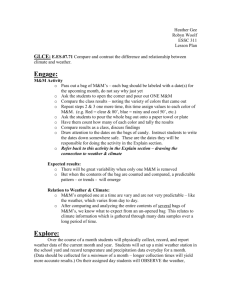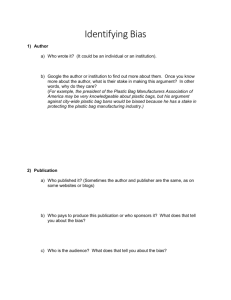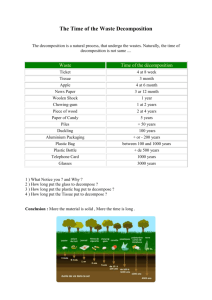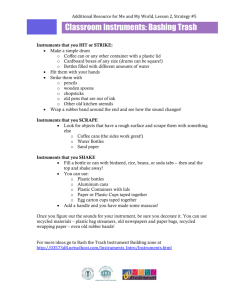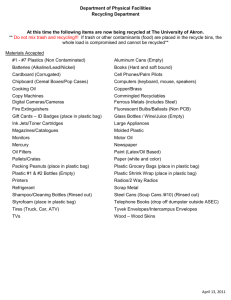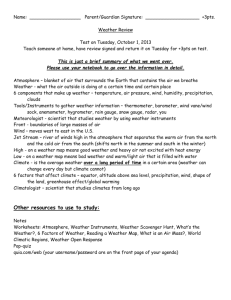General Assessments
advertisement
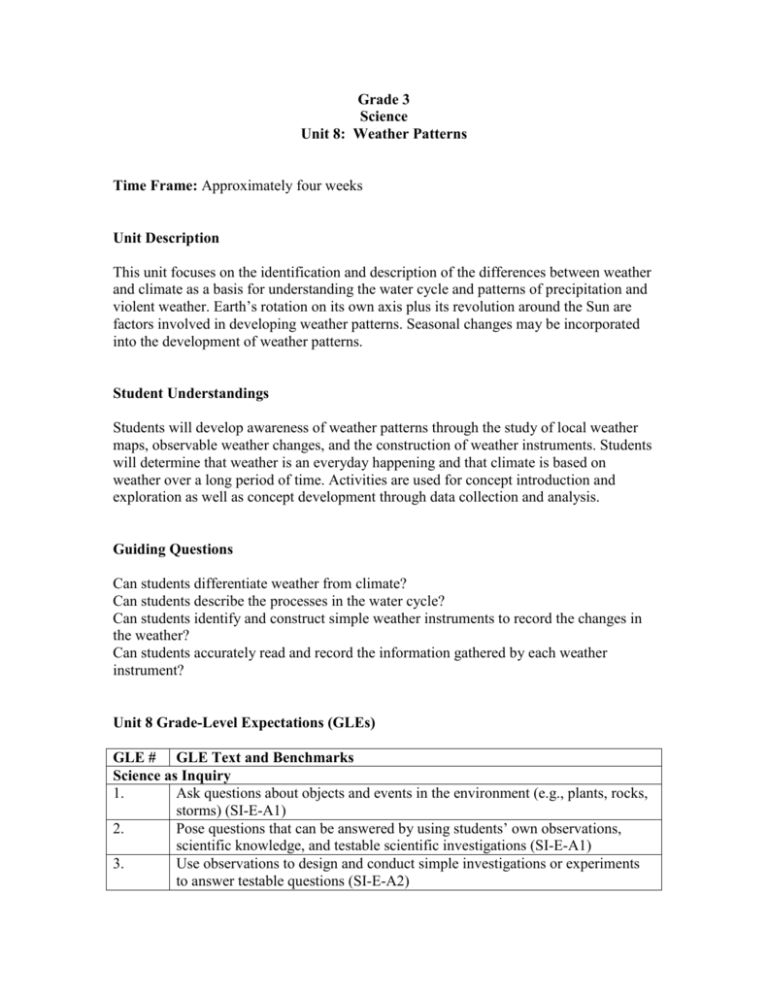
Grade 3 Science Unit 8: Weather Patterns Time Frame: Approximately four weeks Unit Description This unit focuses on the identification and description of the differences between weather and climate as a basis for understanding the water cycle and patterns of precipitation and violent weather. Earth’s rotation on its own axis plus its revolution around the Sun are factors involved in developing weather patterns. Seasonal changes may be incorporated into the development of weather patterns. Student Understandings Students will develop awareness of weather patterns through the study of local weather maps, observable weather changes, and the construction of weather instruments. Students will determine that weather is an everyday happening and that climate is based on weather over a long period of time. Activities are used for concept introduction and exploration as well as concept development through data collection and analysis. Guiding Questions Can students differentiate weather from climate? Can students describe the processes in the water cycle? Can students identify and construct simple weather instruments to record the changes in the weather? Can students accurately read and record the information gathered by each weather instrument? Unit 8 Grade-Level Expectations (GLEs) GLE # GLE Text and Benchmarks Science as Inquiry 1. Ask questions about objects and events in the environment (e.g., plants, rocks, storms) (SI-E-A1) 2. Pose questions that can be answered by using students’ own observations, scientific knowledge, and testable scientific investigations (SI-E-A1) 3. Use observations to design and conduct simple investigations or experiments to answer testable questions (SI-E-A2) GLE # 4. 5. 7. 8. 9. 10. 11. 12. 17. GLE Text and Benchmarks Predict and anticipate possible outcomes (SI-E-A2) Use a variety of methods and materials and multiple trials to investigate ideas (observe, measure, accurately record data) (SI-E-A2) Measure and record length, temperature, mass, volume, and area in both metric system and U.S. system units (SI-E-A4) Select and use developmentally appropriate equipment and tools (e.g., magnifying lenses, microscopes, graduated cylinders) and units of measurement to observe and collect data (SI-E-A4) Express data in a variety of ways by constructing illustrations, graphs, charts, tables, concept maps, and oral and written explanations as appropriate (SI-EA5) (SI-E-B4) Combine information, data, and knowledge from one or more of the science content areas to reach a conclusion or make a prediction (SI-E-A5) Use a variety of appropriate formats to describe procedures and to express ideas about demonstrations or experiments (e.g., drawings, journals, reports, presentations, exhibitions, portfolios) (SI-E-A6) Identify and use appropriate safety procedures and equipment when conducting investigations (e.g., gloves, goggles, hair ties) (SI-E-A7) Explain and give examples of how scientific discoveries have affected society (SI-E-B6) Earth and Space Science 47. 48. 49. Describe the difference between weather and climate (ESS-E-A2) Identify examples of the processes of a water cycle (e.g., evaporation, condensation, precipitation, collection of runoff) (ESS-E-A3) Describe climate patterns from recorded weather conditions over a period of time (ESS-E-A4) Sample Activities Activity 1: Modeling the Water Cycle (GLEs: 1, 2, 4, 5, 9, 10, 11, 48) Students will simulate water cycle by making a model of land and ocean in a plastic box (such as a shoebox) with sand, soil, and gravel and adding water. The box needs to be filled about one-third to one-fourth of the way with the soil mixture. Scrape the soil mixture to one end to form a slanted hillside. Pour two cups of warm water on the plastic at the other end of the hillside. Do not pour water on the soil. Quickly cover the box with plastic wrap and secure with a rubber band. Place a frozen ice pack, such as those used for lunchboxes (or a zipper bag containing ice cubes) on the plastic wrap directly over the soil, or hill. Observe the changes that occur for approximately ten minutes. Condensation and precipitation will occur. No heat lamp is needed. Have students write their predictions of the outcome. Students will observe the demonstration, then draw the water cycle with labels and write an explanation in journals. Remove plastic wrap and let the water evaporate. Examine box after all water has evaporated. Ask students what happened to the water they put in the box. Another model of the water cycle can be demonstrated as follows: Place a cup of water with two or three drops of food coloring into a gallon plastic zipper seal storage bag and place on a sunny window for observation over a period of a few days. Tape a picture of the water cycle to the back of a zipper lock plastic bag before placing in the sunny window. Students will be able to observe the condensation inside of the bag and the precipitation as it runs down the side of the bag. The colored water will allow the students to see that the water did not spill from the cup but did evaporate. Ask students what would happen to the water if the bag were left open in the sunny window. Have students write their predictions of the outcome. Using a globe of Earth, students will observe that approximately three-fourths of Earth is covered with water. Teacher leads discussion about the relation of the water cycle to the amount of water on Earth. Discuss and relate that to the water cycle. Activity 2: Weather Instruments (GLEs: 2, 3, 4, 5, 7, 8, 9, 10, 11, 12, 17, 47, 49) Students will make instruments to measure precipitation, wind speed, and wind direction. After explaining to the students the procedure for making the various instruments, have them identify safety issues that should be addressed in each step. Using clear plastic jars or two or three-liter empty drink bottles with the top cut off make rain gauges. Secure a plastic ruler with inch and centimeter markings onto the outside of the bottle using several large rubber bands making sure the bottom of the ruler is even with the bottom of the bottle with zero being at the bottom. Place the bottle in an undisturbed open area, such as in the schoolyard. Check the amount daily and record the result in a daily journal and a class graph. Empty any precipitation after each recording. Instruments will be observed over a period of time and data recorded. The teacher determines the number of days to observe. Have students brainstorm ideas of how wind movement could be measured. Ask: How could we determine the wind movement here at school? Why would knowing the wind movement be important? A windsock can be made from a small plastic garbage bag. Two windsocks can be made from one bag by cutting it in half length-ways and cutting off the solid end. Teacher caution the students when using scissors and staples to remember safety rules. Make a cylinder shape out of the bag by overlapping the edges. Tape or staple overlapping edges. Using scissors, cut up about four or five inches every inch or so around the bottom of the cylinder to make a fringe. Attach a piece of string to the top to hang the windsock in an area at school that can be checked easily and the wind can reach it and it can blow freely. Students record wind descriptions on a class graph and in science journal. A wind scale, such as provided below, will be analyzed to determine the best wind speed for certain activities (e.g., kite flying, picnic). Speed (km/h) 0 6-19 Description No breeze Light breeze 20-38 Moderate breeze 39-49 Strong breeze Wind Scale Objects Affected No movement of wind Leaves rustle, wind vanes move, wind felt on face Dust and paper blow, small branches sway Umbrellas hard to stay open, large branches sway Windsock Position Sock hangs down Sock blows slightly Sock extended 2/3 of way Sock straight out To make a wind vane take a piece of cardboard and cut out an arrow shape. Teachers remind students to use caution when working with sharp instruments. Insert a straight pin through the middle of the arrow. Push the pin through the eraser end of a pencil. Take the vane outdoors and hold it up into the air. The arrow will turn around in the wind. The arrow will point into the wind meaning this is the direction from which the wind is blowing. (If the arrow points to the north, the wind is coming from the north. It is a north wind.) Students record wind direction on a class graph and in a science journal. Have students make predictions about the direction of the wind by observations of surroundings such as trees, bushes, etc. Have students describe the weather pattern over the specified time period. Students use the data collected over several days or weeks to make inferences about weather patterns. Introduce the difference between weather and climate by displaying the weather pattern in a distinctly different part of the world for the same time period. Students have been studying daily weather patterns. Teacher explains that weather patterns over a long period of time for any given location make up the climate of that region and would be established by records over several years. Have students use information and data collected to make a conclusive statement of the climate of the area they live in. Discussion questions may include: How would weather forecasting and developing technology help us as citizens prepare for natural disasters such as hurricanes or tornadoes? What other resources could weather forecasters use to gather weather information? (satellites, weather balloons, hurricane watchers, etc.) Activity 3: Weather Patterns to Climate (GLEs: 1, 2, 3, 4, 5, 7, 8, 9, 10, 11, 17, 47, 49) Students will collect weather maps from local newspapers to analyze weather patterns. They will listen to/watch news reports on the weather. A personal student calendar and a class calendar will be kept to record daily weather conditions. Teacher may want to appoint different students daily to play the role of Class Meteorologist gathering some of the information the class will need to make a journal entry. Students can check weather using weather sites and/or television station sites. Thermometers measuring outside temperature will be read and temperatures recorded daily using both metric (SI) and US system. Students will keep an accurate record using a table or a data chart of weather conditions noting amounts of rainfall, wind speed and wind direction, as well as outside temperature for at least one month in their journals and on a class graph. Students can also include types of clouds in their daily journal writings from the four types of clouds (Cirrus, Stratus, Cumulus, and Cumulonimbus). Weather conditions, such as temperature and precipitation, will also be graphed. Weather maps will be analyzed over a four-day period to predict weather patterns. Have students research different scientific discoveries (satellites, NASA, more accurate weather instruments) that have helped society become better prepared for storms, tornadoes, flooding, etc. Extension: Students will prepare a severe weather checklist and a hurricane emergency preparedness list to share with peers and parents. This information can be found on a Hurricane Tracking Chart, available at www.stormfax.com, www.noaa.org, and various television news channel stations. Through probing questions, have students discuss the distinction between the terms weather, weather patterns, and climate. Also, have the students discuss their relationships. Have students record their understandings in the journal. Provide student groups with data from specific locations; have students review weather conditions and trends over a long period of time to enable them to describe climate patterns. Use social studies books or nonfiction books about other regions that have climate listed in them. Have students include in their written response major weather measurements/conditions that helped to classify the area as being located in a particular climate. Sample Assessments General Guidelines Assessment techniques should include use of drawings/illustrations/models, laboratory investigations with reports, laboratory practicals (problem-solving and performancebased assessments), group discussion and journaling (reflective assessment), and paperand-pencil tests (traditional summative assessments). Students should be monitored throughout the work on all activities via teacher observation and lab notebook entries. All student-developed products should be evaluated as the unit continues. Student investigations should be evaluated with a rubric. For some multiple-choice items on written tests, ask students to write a justification for their chosen response. General Assessments The student will simulate the water cycle by developing a model of land and ocean in a plastic box. The student will record in journals the role the ocean plays in our water cycle. The student will make rain gauges to measure precipitation, windsocks to measure wind speed, and wind vanes to show direction of wind. The student will record precipitation, wind direction, and wind speed in journals. The student will explain the difference between weather and climate. The student will record weather data in journals. Activity-Specific Assessments Activity 1: Students will correctly draw and label a picture of the water cycle using terminology including but not limited to: evaporation, condensation, and precipitation. Activity 2: Using Internet, newspaper, or television resources to gain examples of weather patterns from other parts of the world, students should compare the weather of their region with the weather of that other country on the same days of the week. The students should be able to explain the difference in weather and climate related to this observation. Activity 3: Have student record daily entries of weather conditions in a journal. Students’ weather journals will be checked for daily entries for a specified amount of time. Award points for making daily entries, recording all the required information daily, and keeping accurate weather instrument information. Students will write journal entries predicting the weather for the next day. (Points should not be taken away for not correctly predicting the weather but should be given for a practical explanation of what the student thinks will happen with the weather.) Resources Bosak, Susan V. Science Is. Scholastic, ISBN 5-590974070-9 http://www.weather.com http://www.thesolutionsite.com http://ga.water.usgs.gov/edu/watercycle.html www.stormfax.com www.noaa.org www.fema.gov/kids/whatnow/index.htm Newspapers TV stations

